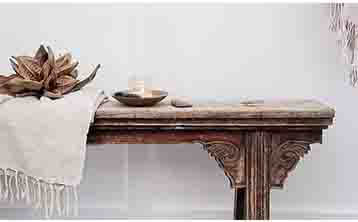-
01of 05
Simplicity
-
There are a few easy ways to achieve the Japandi Look with any space,” says Lita, “I would start with a nice clean slate.” The best way to start is to declutter and only keep the items that serve a purpose for the space. “Minimalism is key, with a nice free flow to the room, when it comes to Japandi,” explains Lita.
Japandi is more than just a trendy style; it’s also a lifestyle. “In our hectic lives, we have learned to take a backseat to calm and serenity,” explains Rhiannon, “People are seeking out simplicity and desperate to create sanctuary-like environments to retreat to.” By removing the clutter, you allow the simplicity, functionality, and craftsmanship of each piece to breathe.
“Don’t be confused with the minimalist message,” says Rhiannon, “It’s about intention not a feeling of bareness.” She further explains that each piece earns its place and holds its own. “They all have a purpose and bring something meaningful to the space,” says Rhiannon.
-
02of 05
Open it Up
-
Large open spaces that allow natural light to flow are a must to achieve the Japandi style. “Japanese and Scandinavian minimalism is best showcased in large open plan areas and it allows the hero pieces to shine and promotes an overall feeling of spaciousness and calm,” explains Rhiannon. One way to get this look without having to take down walls is to use low furniture.
Try low benches, armchairs, beds, and coffee tables, and feel free to mix and match different furniture for added texture and contrast. Low furniture helps make the space visually open, interesting, and authentic. But, don’t go overboard. “You want your space to be obstacle-free for a minimalist look and be able to freely flow throughout your space,” says Lita.
-
03of 05
Quality Over Quantity
-
Less is more in a Japandi home. When choosing accessories and furniture, Lita suggests limiting your selection to thoughtful and functional pieces. “This style uses multi-functional pieces of furniture in the home,” says Lita, “Furniture is practical and simple.”
Think of each piece as a long-term investment. “Don’t be afraid to take your time,” says Rhiannon, “List out the necessary pieces and hunt down the ones that make your heart sing.”
When selecting furniture or accessories, stick with clean lines. “From curvilinear, rectilinear, or dramatic lines, the shapes of specific furniture pieces and artwork are chosen with great purpose to be appreciated and noticed,” says Rhiannon.
-
04of 05
Neutral Color Palette
Lita says to stick with a warm, neutral palette when it comes to the Japandi aesthetic. Think beiges, creams, oatmeals, tans, and stone colors. “Bringing in some traditionally Scandinavian neutrals and fusing them with darker Japanese style timbers and raw materials is a natural partnership that promotes feelings of tranquility and cohesion,” says Rhiannon.
A neutral palette doesn’t have to be boring. The key to making it really stand out is with contrast and is achieved with the depth of color that reflects the Japanese traditional style. “Think indigo blues, dark greys, deep earthy tones to challenge your Scandinavian neutrals,” suggests Rhiannon. However, don’t go overboard with it. Rhiannon recommends using darker colors sparingly and intentionally throughout the home.
-
05of 05
Keep it Natural
Natural materials are another element in the Japandi style, especially sustainable materials. Iron, marble, leather, wood, bamboo, rattan, seashells, feathers, timber stools, sisal rugs, paper, terracotta pots, wool, raw wood, linen, and hemp are all elements that will encompass the hybrid aesthetic. “Try to merge the lines between indoor and outdoor where possible,” says Rhiannon, “Both cultures have a deep respect for their landscape and its aesthetic qualities.”
Lita suggests bringing in ceramics, books, foraged plants or branches, and comforting items like a cozy throw, cushions, candles, and incense. “Part of the beauty in this aesthetic is good things take patience and celebrating what is,” says Lita.
-
-
-
Easy Ways to Add Japandi Style to Your Home
Style to Your Home
Easy Ways to Add Japandi Style to Your Home

It’s been one of my dreams to see design influences from Japan and Scandinavia merging and becoming one style that encompasses all the elements I love most. That merger is called Japandi, and it is an obvious pairing as both aesthetics share similar principles. They celebrate minimalism and emphasize functionality with an infusion of natural influences.
The beauty of this style is that it’s easy to implement in your home with a few steps. Interior designers Lita Lee of Crave Interiors and Rhiannon Lee (no relation) of Oleander and Finch Interiors show us five ways to add the Japandi style to your home.




